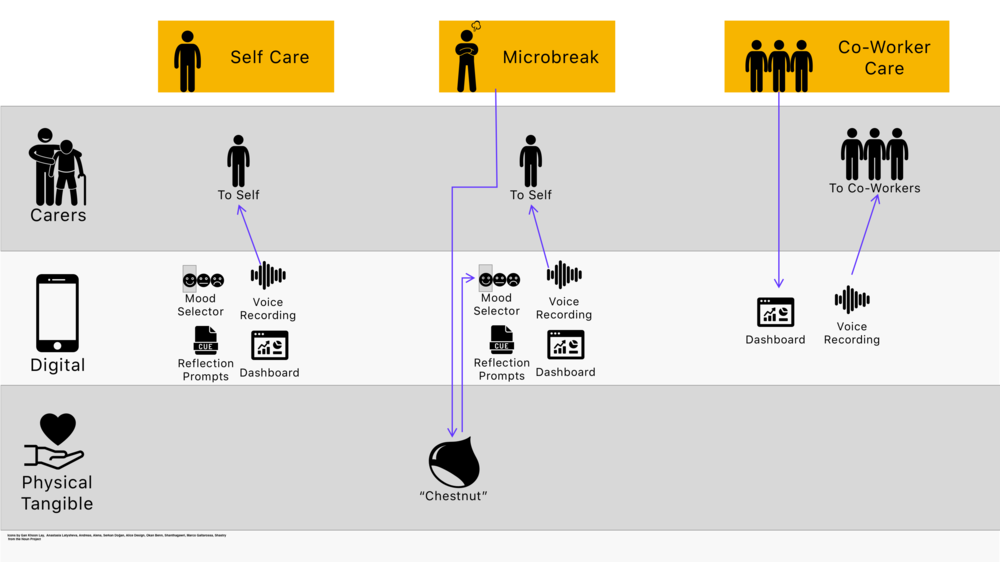Stille Concept
Stille is a service which aims to help caregivers maintain their empathy and their energy to care, by supporting caregivers’ emotional well-being.
It does this through three modules, which
– Allow caregivers to emotionally support each other through sending audio messages of appreciation
– Provide timely prompts for caregivers to reflect on their day and visualizing the caregiver’s mood patterns
– Provide micro-breaks at a physical break station
 Service blueprint for Stille
Service blueprint for Stille
Stille – Concept video from CIID IDP on Vimeo.
The solution strategy was to recharge the energy and empathy of the caregiver by appreciation and gratitude (which are positive expressions of empathy), either through individual mechanisms (via the Self-Care and Micro-break modules) or through their co-workers (Co-Worker Care module). The positive empathy could then cascade through the eldercare institution, via the Co-Worker Care module.
 Solution strategy of replenishing the energy and empathy of the caregiver, building a virtuous cycle throughout the institution.
Solution strategy of replenishing the energy and empathy of the caregiver, building a virtuous cycle throughout the institution.
1- Co-worker Care Module
Stille – Co-worker Care Module from CIID IDP on Vimeo.
This module allows the sending of audio messages of appreciation and thanks, between co-workers.
Research pointed to a lack of emotional support as a critical gap; at the same time, most caregivers I interviewed relied heavily on their co-workers for ad hoc emotional support. This can be difficult during the shift, as the pace can be very frantic. After the shift, the co-workers tend to split their own way, and sometimes do not see each other for days.
This service module is delivered digitally via a mobile app, allowing co-workers to record and send audio messages after the shifts. It was influenced by Design Principles 2, 3 and 5.
 Feedback from caregivers after the project.
Feedback from caregivers after the project.
The sharing of audio messages of appreciation was tested via a Whatsapp chat group amongst some of the caregivers: the result was good enough that they continued with the practice even after my project was over (see pictures).
2 – Self Care Module
Stille – Individual Reflection Module from CIID IDP on Vimeo.
This module supports caregivers’ self-care, by allowing them to reflect individually. The module allows caregivers to
- view their recent moods and microbreaks history with a dashboard
- track their moods
- reflect on prompt questions, curated to help them process their emotions (based on their moods)
- record an audio journal
Research indicated that not all caregivers dealt with stress by going to their co-workers: some needed their own time away. Some talked aloud, even to themselves, and a number of them reflected on their own emotions (see Design Principle 2) and work at the end of the day. The audio journal and prompt questions were influenced by Design Principle 5.
This module is delivered digitally via a mobile app, allowing caregivers to conveniently access this module during the shift and after work.
3- Microbreak Station Module
Stille – Microbreak Module from CIID IDP on Vimeo.
This module augments the caregivers’ existing rest areas in the nursing home, with a physical vibrating “chestnut”* that helps take their mind away from their stress. It is activated by the caregiver surrendering their phone to the station, and by picking up the “chestnut”.
Research indicated that caregivers would “escape” to certain areas out of sight from the residents to get some rest and respite. Sometimes the caregivers would just look out the windows; sometimes they would end up engrossed with their phones. The soothing nature of tactile interactions (see Design Principle 4) was tapped on to augment the rest areas, to help create a break (see Design Principle 1).
(*Note: chestnuts have a special significance in Danish culture. It signifies the arrival of autumn, and many Danes carry a “lucky chestnut” in their pockets in the autumn.)